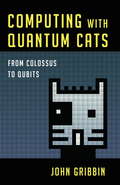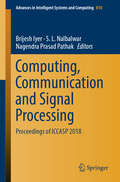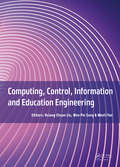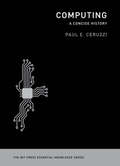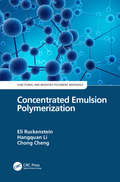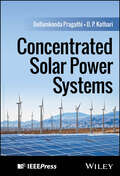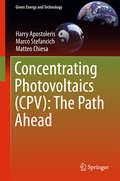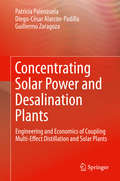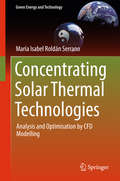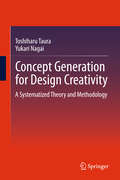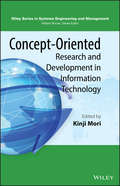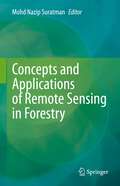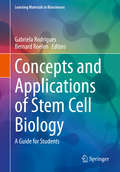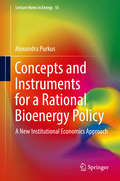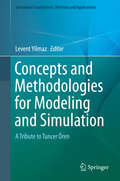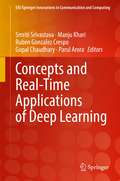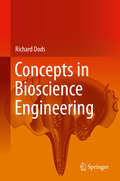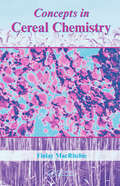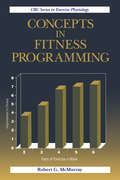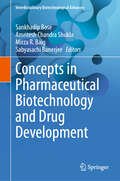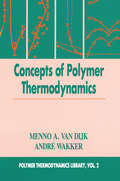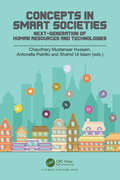- Table View
- List View
Computing with Quantum Cats
by John GribbinA mind-blowing glimpse into the near future, where quantum computing will have world-transforming effects.The quantum computer is no longer the stuff of science fiction. Pioneering physicists are on the brink of unlocking a new quantum universe which provides a better representation of reality than our everyday experiences and common sense ever could. The birth of quantum computers - which, like Schrödinger's famous "dead and alive" cat, rely on entities like electrons, photons, or atoms existing in two states at the same time - is set to turn the computing world on its head.In his fascinating study of this cutting-edge technology, John Gribbin updates his previous views on the nature of quantum reality, arguing for a universe of many parallel worlds where "everything is real." Looking back to Alan Turing's work on the Enigma machine and the first electronic computer, Gribbin explains how quantum theory developed to make quantum computers work in practice as well as in principle. He takes us beyond the arena of theoretical physics to explore their practical applications - from machines which learn through "intuition" and trial and error to unhackable laptops and smartphones. And he investigates the potential for this extraordinary science to create a world where communication occurs faster than light and teleportation is possible.This is an exciting insider's look at the new frontier of computer science and its revolutionary implications.
Computing, Communication and Signal Processing: Proceedings Of Iccasp 2018 (Advances In Intelligent Systems and Computing #810)
by Brijesh Iyer S. L. Nalbalwar Nagendra Prasad PathakThis book highlights cutting-edge research on various aspects of human–computer interaction (HCI). It includes selected research papers presented at the Third International Conference on Computing, Communication and Signal Processing (ICCASP 2018), organized by Dr. Babasaheb Ambedkar Technological University in Lonere-Raigad, India on January 26–27, 2018. It covers pioneering topics in the field of computer, electrical, and electronics engineering, e.g. signal and image processing, RF and microwave engineering, and emerging technologies such as IoT, cloud computing, HCI, and green computing. As such, the book offers a valuable guide for all scientists, engineers and research students in the areas of engineering and technology.
Computing, Control, Information and Education Engineering: Proceedings of the 2015 Second International Conference on Computer, Intelligent and Education Technology (CICET 2015), April 11-12, 2015, Guilin, P.R. China
by Wen-Pei Sung Hsiang-Chuan Liu Wenli-YaoThis proceedings set contains selected Computer, Information and Education Technology related papers from the 2015 International Conference on Computer, Intelligent Computing and Education Technology (CICET 2015), to be held April 11-12, 2015 in Guilin, P.R. China. The proceedings aims to provide a platform for researchers, engineers and academics
Computing: A Concise History (The MIT Press Essential Knowledge series)
by Paul E. CeruzziA compact and accessible history, from punch cards and calculators to UNIVAC and ENIAC, the personal computer, Silicon Valley, and the Internet.The history of computing could be told as the story of hardware and software, or the story of the Internet, or the story of “smart” hand-held devices, with subplots involving IBM, Microsoft, Apple, Facebook, and Twitter. In this concise and accessible account of the invention and development of digital technology, computer historian Paul Ceruzzi offers a broader and more useful perspective. He identifies four major threads that run throughout all of computing's technological development: digitization—the coding of information, computation, and control in binary form, ones and zeros; the convergence of multiple streams of techniques, devices, and machines, yielding more than the sum of their parts; the steady advance of electronic technology, as characterized famously by “Moore's Law”; and the human-machine interface.Ceruzzi guides us through computing history, telling how a Bell Labs mathematician coined the word “digital” in 1942 (to describe a high-speed method of calculating used in anti-aircraft devices), and recounting the development of the punch card (for use in the 1890 U.S. Census). He describes the ENIAC, built for scientific and military applications; the UNIVAC, the first general purpose computer; and ARPANET, the Internet's precursor. Ceruzzi's account traces the world-changing evolution of the computer from a room-size ensemble of machinery to a “minicomputer” to a desktop computer to a pocket-sized smart phone. He describes the development of the silicon chip, which could store ever-increasing amounts of data and enabled ever-decreasing device size. He visits that hotbed of innovation, Silicon Valley, and brings the story up to the present with the Internet, the World Wide Web, and social networking.
Concealed
by Christina Diaz GonzalezThe 2022 Edgar Award Winner for Best Juvenline Mystery! What if you had no name, no past, and no home?Ivette. Joanna. And now: KatrinaWhatever her name is, it won’t last long. Katrina doesn’t know any of the details about her past, but she does know that she and her parents are part of the Witness Protection Program. Whenever her parents say they have to move on and start over, she takes on a new identity. A new name, a new hair color, a new story.Until their location leaks and her parents disappear. Forced to embark on a dangerous rescue mission, Katrina and her new friend Parker set out to save her parents—and find out the truth about her secret past and the people that want her family dead.But every new discovery reveals that Katrina’s entire life has been built around secrets covered up with lies and that her parents were actually the ones keeping the biggest secret of all. Katrina must now decide if learning the whole truth is worth the price of losing everything she has ever believed about herself and her family.
Concentrated Emulsion Polymerization
by Eli Ruckenstein Hangquan Li Chong ChengComprising one volume of Functional and Modified Polymeric Materials, Two-Volume Set, this curated collection of papers by Professor Eli Ruckenstein and co-workers discusses the merits of concentrated emulsion polymerization systems, as well as their ability to yield a broad variety of products with high synthetic efficiency. Comprised of carefully curated chapters previously published by these pioneering scientists in the field, this volume offers a comprehensive view of the subject and presents functional and modified polymeric materials prepared by concentrated emulsion polymerization approaches. It covers conductive polymer composites, core-shell latex particles, enzyme/catalyst carriers, and plastics toughening and compatibilization polymerization. The authors have performed seminal studies on the preparation of functional and modified polymeric materials via concentrated emulsion polymerization. The corresponding research papers, after further selection and classification, are collected in the four chapters of this book.
Concentrated Solar Power Systems
by D. P. Kothari Bellamkonda PragathiFollow the performance assessment tools and methods currently used for concentrated solar power technology (CSP) in this unique, single source overview The search for renewable energy sources and methods for harnessing them is perhaps the most significant challenge of the twenty first century, which faces the potentially existential crises of global climate change. Concentrated solar power, or CSP, has the potential to revolutionize energy production. Its integration of thermal energy and its capacity to work with traditional power generation cycles make it an ideal tool for a newly sustainable world. Concentrated Solar Power Systems is an advanced-level book offering both theoretical and practical perspectives on CSP. Its thorough overview of this technology includes the foundational scientific principles, system design and development, and growing applications. It offers a one-stop source for the performance assessment tools and methods currently deployed in the area of concentrated solar power. Readers will also find: Case studies throughout showing CSP harnessed to meet real energy needs Detailed discussion of topics including site selection, feasibility analysis, environmental assessments, and more Analysis of specific technologies including linear Fresnel reflectors, parabolic troughs, concentrating photovoltaic systems, and many others Concentrated Solar Power Systems is ideal for students and researchers involved or interested in the design, production, development, optimization, and application of CSP technology.
Concentrated Solar Thermal Energy Technologies: Recent Trends and Applications (Springer Proceedings in Energy)
by Laltu Chandra Ambesh DixitThe proceedings entitled "Concentrated Solar Thermal Technologies: Recent Trends and Applications" includes the peer-reviewed selected papers those are presented during NCSTET 2016. The sub-topics under concentrated solar thermal technologies and applications included in the book are Solar Field; Receiver and Heat Exchanger; Coating; Thermal Energy Storage; Cooling; Process Heat; and Smart Grid and Policy Research. The domains mentioned cover topics from resource-assessment, collection to conversion of solar energy for applications, like, heating, cooling and electricity. The proceedings also include invited lectures from domain experts. The edited work will be useful for beginners and for the advanced level researchers in the field of concentrated solar thermal technologies and their applications.
Concentrating Photovoltaics (Green Energy and Technology)
by Harry Apostoleris Marco Stefancich Matteo ChiesaThis book is a concise review of the current status and future prospects of concentrating photovoltaic (CPV) technology. Starting with a summary of the current technical and economic status of CPV technology, it identifies the factors that hold CPV back in the commercial market. The main technical areas considered are solar cells, tracking and optics. The solar cells section focuses on spectrum splitting systems, which offer potentially higher efficiency than multi-junction cells with reductions in the manufacturing constraints that lead to high costs. It also offers a brief survey of the latest developments in spectral splitting alongside a discussion of the advances in solar cell manufacturing that aid the development of such systems. Further, it examines electrical design principles for spectral splitting systems that can improve the spectral stability of these systems' performance. The section on tracking includes a description of tracking integration with an update of the review published in Nature, presenting the latest advances in the field and focusing on surveying conceptual approaches rather than providing an exhaustive description of the literature. The optics section explores 3D printing and other emerging methods of fabricating optics for both prototype and large-scale production, as well as new classes of concentrators, particularly those based on novel photonic materials such as angular filters. Lastly, the authors consider the impact that environmental factors have on the performance of CPV in non-standard environments before concluding with a discussion of the combinations of technologies that they anticipate will most effectively boost CPV in the commercial market.
Concentrating Solar Power and Desalination Plants: Engineering and Economics of Coupling Multi-Effect Distillation and Solar Plants
by Patricia Palenzuela Diego-César Alarcón-Padilla Guillermo ZaragozaThis book provides a detailed examination of how two key concerns in many communities across the globe- power and water- can be simultaneously addressed through the coupling of Concentrating Solar Power and Desalination (CSP+D) plants. It undertakes a technological and economic evaluation of the integration of Multi-effect Distillation Plants into CSP plants based on Parabolic Trough solar collectors (PT-CSP+MED), as compared to independent water and power production through Reverse Osmosis unit connection to a CSP plant (CSP+RO). Through this compare and contrast method of analysis, the author establishes guidelines to assist readers in identifying cases wherein PT-CSP+MED systems provide greater benefits from a thermodynamic and economic point of view. The text outlines efficiencies and challenges derived from the combination of PT-CSP power generation with four different desalination plant scenarios, beginning with a description of the equations used in the modeling and validation of a pilot MED plant and followed by detailed thermodynamic analysis of several currently operating CSP+D systems. Comparative thermodynamic assessments are based on a sensitivity analysis from which the overall efficiency of the cogeneration system is determined. The author outlines all the equations used for the modeling of each component and includes 97 comparative tables obtained from the sensitivity analysis, showing the variation of the overall thermal efficiency of the CSP+D as a function of fundamental parameters of the cogeneration cycle, such as the specific electric consumption of the desalination plants, and the turbine outlet temperature of the power cycle. These findings are then placed in practical context through a complete thermo-economic analysis, which is carried out for two specific locations in the Middle East and Europe in order to identify the most practically and economically viable CSP+D system in each region as informed by actual operating conditions, meteorological data and real cost figures for each location.
Concentrating Solar Thermal Technologies: Analysis and Optimisation by CFD Modelling (Green Energy and Technology)
by Maria Isabel Roldán SerranoThis book addresses the evaluation and optimization of key elements in concentrating solar thermal (CST) technologies, such as solar receivers and working fluids, using computational fluid dynamics (CFD) modeling. It discusses both general and specific aspects, explaining the methodology used to analyze and evaluate the influence of different parameters on the facility performance. This information provides the basis for optimizing design and operating conditions in CST systems.
Concept Generation for Design Creativity: A Systematized Theory and Methodology
by Yukari Nagai Toshiharu TauraThe concept generation process seems like an intuitional thought: difficult to capture and perform, although everyone is capable of it. It is not an analytical process but a synthetic process which has yet to be clarified. Furthermore, new research methods for investigating the concept generation process--a very difficult task since the concept generation process is driven by inner feelings deeply etched in the mind--are necessary to establish its theory and methodology. Concept Generation for Design Creativity - A Systematized Theory and Methodology presents the concept generation process both theoretically and methodologically. Theoretically, the concept generation process is discussed by comparing metaphor, abduction, and General Design Theory from the notions of similarities and dissimilarities. Analogy, blending, and integration by thematic relation have been explained methodologically. So far, these theories and methods have been discussed independently, and the relations among them have not been clarified. Two newly developed research methods to investigate the concept generation process are clearly explained: the explanation-based protocol analysis and constructive simulation. By reading Concept Generation for Design Creativity - A Systematized Theory and Methodology, students, researchers and lecturers in design disciplines (including engineering design, industrial design, software design, CHI, design education, and cognitive science ) can obtain a clear picture of the advanced research findings and the outline of the theories and methods for concept generation. Furthermore, readers are expected to achieve the competence to generate new concepts.
Concept-Oriented Research and Development in Information Technology
by Kinji MoriThis book thoroughly analyzes the relationships between concept, technology, and market--which are the main factors in shifting information technology research and development (R&D) to a new approach. It discusses unconventional methods and viewpoints of concept creation, technology innovation, and market cultivation. Featuring contributions from international experts and case studies from IBM and Hitachi, this book is perfect for graduate students in information technology, engineering, technology management, operation research, and business--as well as for R&D researchers, directors, strategists, business managers, and government and industry professionals.
Concepts and Applications of Remote Sensing in Forestry
by Mohd Nazip SuratmanThis edited book is a collection of information on recent advancements in remote sensing for forestry application. The main focus of this book is to address the novel applications in remote sensing in terms of recent techniques, sensors, methods and data collection. Remote sensing has been used for many decades. Today, remote sensing is heavily utilized in forest management, which is acquired from airborne and space-borne platforms using satellite data. In recent years, there have been rapid advances in the new types of sensors. The new generations of satellite sensors are introduced not only to provide important information on forest ecosystems, but also to improve the techniques and accuracies obtained by the traditional approaches. Researchers have become increasingly aware of the potential of remote sensing to address important forestry issues and challenges. The number of forestry publications using remote sensing has grown very rapidly, and this is noticeable with many recent technologies and applications. This book provides valuable source of reference to foresters, researchers, ecologists, climate change scientists and scholars who use remote sensing in their work. Furthermore, it serves as an academic book for undergraduate and graduate students of forestry, agriculture, natural resources and environmental sciences. The book demonstrates and engages the students how the new advancements in remote sensing technology and theory relate to the many real-world forestry applications. It gives readers deeper understanding on how remote sensing has come a long way and evolved into a mature science in the past five decades.
Concepts and Applications of Stem Cell Biology: A Guide for Students (Learning Materials in Biosciences)
by Gabriela Rodrigues Bernard A. J. RoelenThis textbook will support graduate students with learning materials rich in the basic concepts of stem cell biology, in its most widespread and updated perspective. The chapters are conceived in a way for students to understand the meaning of pluripotency, the definition of embryonic stem cells and the formation of multicellular structures such as organoids together with the underlying principles of their epigenetic. This textbook also discusses adult stem cells and the potential use of these cells, in particular neural, mesenchymal, and several types of muscular cells, in biomedical research and clinical applications.This textbook represents a vital complement to the text on Essential Current Concepts of Stem Cell Biology, also published in the Learning Materials in Biosciences textbook series.
Concepts and Challenges: Earth and Space
by Leonard Bernstein Martin Schachter Alan Winkler Stanley WolfeIn this book, students will use a variety of science process skills to understand the facts and theories in Earth and Space science.
Concepts and Instruments for a Rational Bioenergy Policy: A New Institutional Economics Approach (Lecture Notes in Energy #55)
by Alexandra PurkusThis book provides an in-depth economic analysis of the challenges associated with bioenergy use and production. Drawing on New Institutional Economics and the theory of economic policy, it develops theory-based recommendations for a bioenergy policy that strives for efficiency and sustainability. Further, it shows how to deal with diverse uncertainties and constraints, such as institutional path dependencies, transaction costs, multiple and conflicting policy aims, and interacting market failures, while also applying the resulting theoretical insights to a case study analysis of Germany's bioenergy policy. As such, the book aims to bridge the gap between practical bioenergy policymaking on the one hand, and neoclassical theory-based concepts that strictly focus on a minimization of greenhouse gas mitigation costs on the other.
Concepts and Methodologies for Modeling and Simulation: A Tribute to Tuncer Ören (Simulation Foundations, Methods and Applications)
by Levent YilmazThis comprehensive text presents cutting-edge advances in the theory and methodology of modeling and simulation (M&S) and reveals how this work has been influenced by the fundamental contributions of Prof. Tuncer Ören to this field. Exploring the synergies among the domains of M&S and systems engineering (SE), the book describes how M&S and SE can help to address the complex problems identified as "Grand Challenges" more effectively under a model-driven and simulation-directed systems engineering framework. Features: examines frameworks for the development of advanced simulation methodologies; presents a focus on advanced modeling methodologies; reviews the reliability and quality assurance of models; discusses the specification and simulation of human and social behavior, including models of personality, emotions, conflict management, perception and anticipation; provides a survey of the body of knowledge in M&S; highlights the foundations established by the pioneering work of Prof. Tuncer Ören.
Concepts and Real-Time Applications of Deep Learning (EAI/Springer Innovations in Communication and Computing)
by Smriti Srivastava Manju Khari Gopal Chaudhary Ruben Gonzalez Crespo Parul AroraThis book provides readers with a comprehensive and recent exposition in deep learning and its multidisciplinary applications, with a concentration on advances of deep learning architectures. The book discusses various artificial intelligence (AI) techniques based on deep learning architecture with applications in natural language processing, semantic knowledge, forecasting and many more. The authors shed light on various applications that can benefit from the use of deep learning in pattern recognition, person re-identification in surveillance videos, action recognition in videos, image and video captioning. The book also highlights how deep learning concepts can be interwoven with more modern concepts to yield applications in multidisciplinary fields.Presents a comprehensive look at deep learning and its multidisciplinary applications, concentrating on advances of deep learning architectures;Includes a survey of deep learning problems and solutions, identifying the main open issues, innovations and latest technologies;Shows industrial deep learning in practice with examples/cases, efforts, challenges, and strategic approaches.
Concepts in Bioscience Engineering
by Richard DodsThis textbook teaches bioengineers critical concepts about protein three dimensional structures, how proteins fold, and how the folding affects the functioning of the protein. Protein folding has profound effects on the discovery of biopharmaceutical drugs (especially the transport of immunological compounds to their site of action) as well as on tissue engineering. Dr. Dods covers topics in easily understood terms through the use of glossaries heading each chapter and footnotes and summaries at the end of each chapter. The chapters cover disordered proteins and large sequences of disorder that exists within proteins, secondary structure (α-helix and β-pleated structure), tertiary and quaternary structure, post-translational changes, proteopathies, bioengineering approaches used to study protein folding, and computer software for protein folding. For each of these topics the elements of biomolecular imaging, cellular and tissue engineering, and health care systems engineering are built. Molecular engineering concepts such as site-directed mutagenesis are addressed. For reinforcement of the concepts presented in this text, activities and problems (Queries) are included in the chapter.
Concepts in Cereal Chemistry
by Finlay MacRitchieConcepts in Cereal Chemistry stimulates critical thinking by emphasizing the important concepts related to the science. Written by distinguished researcher and teacher Dr. Finlay MacRitchie, this compact and reader-friendly book focuses mainly on cereal chemistry, but also incorporates relevant theory from the basic sciences, such as physics and ge
Concepts in Fitness Programming (Exercise Physiology Ser. #1)
by Robert G. McMurrayConcepts in Fitness Programming presents comprehensive material about various aspects of exercise testing and prescription in a simple, straightforward manner. Intended for individuals who design exercise and fitness programs but who lack extensive background in fitness training, this book provides a wealth of knowledge beyond the basic "how to's"
Concepts in Pharmaceutical Biotechnology and Drug Development (Interdisciplinary Biotechnological Advances)
by Amritesh Chandra Shukla Sankhadip Bose Mirza R. Baig Sabyasachi BanerjeeThis book provides comprehensive coverage of the development of new pharmaceuticals and the enhancement of existing ones. It offers a comprehensive understanding of pharmaceutical biotechnology, including its underlying principles and practical applications from an industrial standpoint. While introducing the roles and applications of biotechnology in drug design and development, the book describes how developments in other fields, like genomics, proteomics, and high-throughput screening, have facilitated the discovery of novel therapeutic targets and drug development methods. It included concepts that are essential to biotechnology and apply to protein therapies. The book provides a thorough overview of the ways in which biotechnology influences drug development, production, and regulation, and is a valuable resource for those seeking to enhance their understanding in this area. This book is designed to support educators in their teaching efforts and offers a reader-friendly exploration of the various stages involved in developing new pharmaceuticals through biotechnology. This book is a valuable resource for individuals in various academic and professional careers, including undergraduates, graduates, pharmaceutical scientists, clinicians, and academic researchers. It provides convenient access to current practices in pharmaceutical biotechnology, making it particularly useful for those working in the interdisciplinary field of biochemistry, pharmacology, biopharmaceutics, and biotechnology. This book's concise and impartial content structure may also benefit corporate researchers.
Concepts in Polymer Thermodynamics, Volume II
by Menno A. van Dijk Andre WakkerThermodynamics is an indispensable tool for developing a large and growing fraction of new polymers and polymer blends. These two volumes show the researcher how thermodynamics can be used to rank polymer pairs in order of immiscibility, including the search for suitable chemical structure of compatibilizers. Because of the great current commercial interest in this most dynamic sector of the polymer industry, there is high interest in studying their physical and mechanical properties, their structures, and the processes of their formation and manufacture. These Books are dedicated to Analysis of the Thermodynamics of Polymer Blends. Thermodynamic behavior of blends determines the compatibility of the components, their morphological features, rheological behavior, and microphase structures. As a result, the most important physical and mechanical characteristics of blends can be identified.
Concepts in Smart Societies: Next-generation of Human Resources and Technologies
by Antonella Petrillo Chaudhery Mustansar Hussain Shahid Ul IslamWe live in a society driven by rapid and unpredictable changes. The concept of the “fourth industrial revolution” was introduced less than ten years ago - the more aware and reality oriented “smart factories”. By this we mean novelties in production technologies, enabling IT services and greater attention to energy consumption. Today, we are discussing the fifth stage in the evolution of society, the advent of the 5.0 company. This book outlines strategic lines and suggests future directions for the development of the "super smart society" which takes responsibility and ensures sustainability by adhering to new smart technologies and skills. The book is intended for a broad audience working in the fields of material science and engineering, energy, environment, etc. It is an invaluable reference source for researchers, academicians, students, industrial institutions, government and independent institutes, individual research groups and scientists working in the field of industrial applications of smart manufacturing design.
